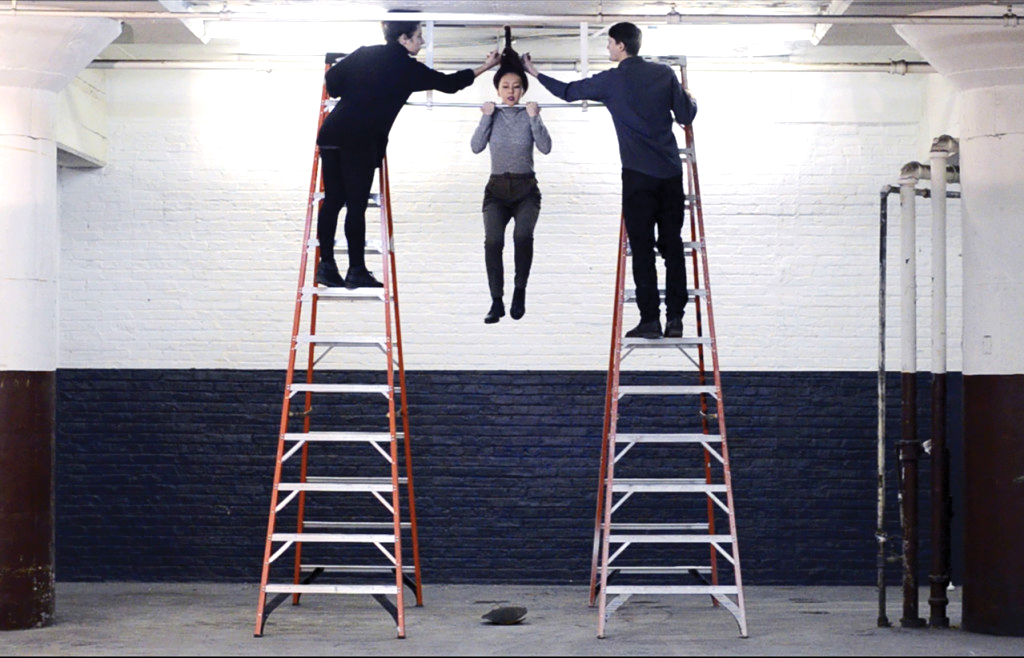
When I entered ACRE gallery in Pilsen for the opening of “Forced Air,” I was almost stabbed. In the middle of the room, only a few feet from the door, a giant sphere sat on the floor, from which various spears and sticks were protruding.
This bizarre sphere (whose given title is “Not Necessarily”), about as big as a medium-sized dog and perforated with holes of different sizes, was the most conspicuous occupant of the gallery on April 27, during the opening of “Forced Air.” The project is a collaboration between artists Jiyoung Yoon and Andy Kincaid, both of whom have extensive backgrounds in installation and sculpture. The perforated sphere, which was Yoon’s doing, shared the hardwood floor with a shattered turtle shell (also part of Yoon’s work), which at least three guests tripped over as they made their way around the small room. Yoon’s work, rather than staying confined to the walls, where gallery viewers generally expect to find art, disrupts the space of the room through its physically invasive placement: several patrons knocked “Not Necessarily” clean over and Yoon, who was present, had to pick it back up.
Bits and pieces of the turtle shell also lay scattered around the room. Around one corner, near the bathroom and a woman selling beer and wine, a Dynex television screen displayed on repeat the most heavily advertised part of Yoon’s work: a video in which she hangs suspended by her hair from the ceiling while two men on ladders cut her hair off in order to free her. When Yoon is finally released, she falls to the ground and lands on a turtle shell, shattering the shell. I watched the video twice and then looked back out into the main room: there was the shell.
Yoon, when she was not walking around the gallery room balancing on just her heels, did her best to explain to me precisely what she was trying to accomplish with her video and her perilous sphere.
“I was thinking about how people want to land somehow,” she said. “How they can be too eager to feel like they have landed, or are grounded. We are not even afraid to hurt anything just to land ourselves.” She gestured to the shell. “The turtle is sacrifice, so we observe all the impact, all the weight. It broke, so I was safe. But I also had pain,” she said, pointing up to the ceiling, where her hair was still dangling from the rafters. She had recreated the scene of the video in the space of the gallery. “I also had pain, so you cannot blame me for causing pain. It’s like a circulation.” The title of the show is “Seeing Things The Way We See The Moon,” she continued, “because, like with the moon, we only see one side of things.”
While Yoon’s work interrupted the open space of the gallery’s center, Kincaid’s work lined the walls: he had supplied four pieces for the gallery, all frustratingly different in size and scheme.
“All the pieces,” explained Kincaid, “are related to how we interact with landscape and natural setting.” He gestured to a small screen on a far wall, which he described as intentionally “iPhone-shaped.” It was displaying a video of a sunset on top of a wider video of the same sunset; the videos shifted and shook on top of each other, occasionally achieving what Kincaid called a “moment of catharsis” when the two horizon lines lined up. Kincaid described the sunset as “an aesthetic object that we can’t help but be drawn to…but one that everyone wants to capture, and it’s there every day.”
Next to the video screen (“Sunrise”) was an enormous murky picture labeled “Collected Sunrise.” It was not clear just what the content of the picture was until Kincaid explained that he had taken a still of the sunset video and searched Google for images similar to it. He had then overlaid the first fifty images the search engine generated, mostly of sunsets and sunrises, to create the murky, watery behemoth of a painting that dominated one wall of the room.
The unifying theme of the work, Kincaid said, was “the way that we interact with [landscape] spaces, and our distortions of our experiences of reality based on how we’re eager to capture parts of that experience.”
On the surface, Kincaid admitted, his work and Yoon’s did not appear to have much in common other than the fact that they were both in the same room.
“But,” he added later on, “think about how Jiyoung’s work is about the artist’s experience, how they see themselves, and in my work you see the viewer’s impact, the artist’s impact, on how they see their environment. I think [our work together] is like a looking in, looking out sort of thing.”
Kincaid and Yoon were looking out, and I was looking in, but what neither of us could deny, looking at the hair dangling from the ceiling or the massive brown painting on the wall, was that there was definitely something to look at.
ACRE Projects, 1913 W. 17th St. Through May 12. Sunday-Monday, noon-4pm. Free. acreresidency.org
